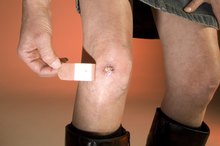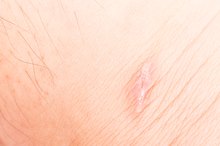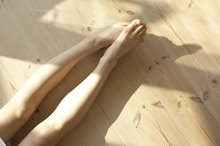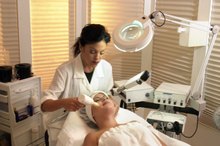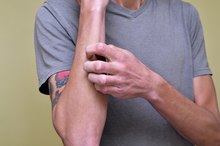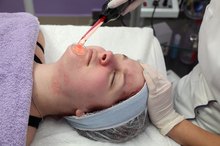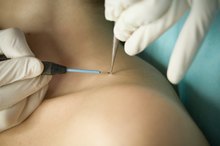What does fact checked mean?
At Healthfully, we strive to deliver objective content that is accurate and up-to-date. Our team periodically reviews articles in order to ensure content quality. The sources cited below consist of evidence from peer-reviewed journals, prominent medical organizations, academic associations, and government data.
The information contained on this site is for informational purposes only, and should not be used as a substitute for the advice of a professional health care provider. Please check with the appropriate physician regarding health questions and concerns. Although we strive to deliver accurate and up-to-date information, no guarantee to that effect is made.
How to Take Away Keloid Scarring
Keloids are an excess growth of scar tissue, generally causing abnormally raised, thick scars on the skin. These scars tend to have jagged edges with a fibrous appearance, and they range in color from pale white to brownish red. They typically develop over several months. Some keloids disappear on their own after many years, but most keloids are impossible to remove without professional treatment. Most over-the-counter keloid removers cannot offer scientific proof of effectiveness, and some studies indicate that these treatments do more harm than good. While you may be able to diminish the appearance of a keloid through skin care and diet, only a professional can remove it entirely.
Gently exfoliate the keloid whenever you shower with a loofah sponge or a liquid scrub, to remove the top layer of skin and encourage new skin growth. Don't scrub too hard or you might promote new scar formation. Alpha hydroxy acid or lemon juice can also remove the top layer of skin. This is especially useful if you have a darkened keloid and want to lighten it.
How to Get Rid of Scars on Legs From Bug Bites
Learn More
Moisturize the keloid four to six times per day. Use a deep conditioning balm such as cocoa butter, shea butter or petroleum jelly. Avoid watery or scented lotions.
Eat a healthful diet rich in foods that promote skin health and drink plenty of water. Vitamin A, vitamin E, vitamin C, zinc and healthful fats are some of the most important nutrients for skin 4. Orange vegetables, citrus fruits, seeds, nuts and olive oil can provide these vital nutrients.
How to Flatten Keloid Scars
Learn More
Exercise regularly and massage the area around the keloid to promote healthy blood flow.
Apply a silicone gel sheet to the keloid. These sheets are available from your doctor or a drugstore. They must usually be worn for several hours a day, and it may take weeks for them to work, but studies such as a 2007 report by Dr. Brian Berman in "Dermatologic Surgery" find that these are one of the most effective treatments, especially for people prone to keloids. Silicone gels, such as Imiquimod, also seem to be effective treatments.
Consult a specialized physician about more invasive therapies such as steroid injections, laser therapy, radiation or freezing. Because keloids are prone to reformation, surgical removal is generally not an effective solution. However, your physician will be able to determine the best treatment for you.
Tips
The best way to treat keloids is to prevent them from occurring. If you know you are prone to keloids, wash your wounds regularly, use plenty of moisturizer, eat a healthful diet and avoid exposing the wound to sunlight.
Scientists continue to develop new scar removal ointments. Ask your doctor about the latest, scientifically proven keloid treatments on the market.
Warnings
Most keloid ointments available on the market have no scientific backing and may cause additional harm. Consult your doctor before using any topical or oral medication, even if it claims to be all-natural.
Related Articles
References
- MedlinePlus; Keloids; Oct. 5, 2010
- "The New York Times"; Keloids; Kevin Berman, MD, PhD, et al.; Oct. 3, 2008
- CNN; What's the Treatment for Keloids?; Jennifer Shu; Mar. 16, 2009
- Natural News; The Top Five Nutrients for Healthy Skin; Mike Adams; Apr. 4, 2007
- Harvard Medical School Harvard Health Publishing. Keloids. Updated April 2019.
- NHS. Keloid scars. Updated June 5, 2019.
- University of Michigan Medicine. Keloid scars.
- Medical University of South Carolina. Scar revision & keloid treatment.
- Westra I, Pham H, Niessen FB. Topical silicone sheet application in the treatment of hypertrophic scars and keloids. The Journal of Clinical and Aesthetic Dermatology. 2016;9(10):28-35.
- NYU Langone Health. Recovery & support for scars & keloids.
- Harvard Medical School Harvard Health Publishing. Keloids. Updated April 2019.
- NHS. Keloid scars. Updated June 5, 2019.
- University of Michigan Medicine. Keloid scars.
- Medical University of South Carolina. Scar revision & keloid treatment.
- Morelli Coppola M, Salzillo R, Segreto F, Persichetti P. Triamcinolone acetonide intralesional injection for the treatment of keloid scars: patient selection and perspectives. CCID. Clin Cosmet Investig Dermatol. 2018;11:387-396. doi:10.2147/CCID.S133672
- Westra I, Pham H, Niessen FB. Topical silicone sheet application in the treatment of hypertrophic scars and keloids. The Journal of Clinical and Aesthetic Dermatology. 2016;9(10):28-35.
- Barara M, Chander R, Mendiratta V. Cryotherapy in treatment of keloids: evaluation of factors affecting treatment outcome. J Cutan Aesthet Surg. 2012;5(3):185-. doi:10.4103/0974-2077.101376
- Rathee M, Kundu R, Tamrakar A. Custom made pressure appliance for presurgical sustained compression of auricular keloid. Ann Med Health Sci Res. 2014;4(8):147-. doi:10.4103/2141-9248.138040
- Xu J, Yang E, Yu N, Long X. Radiation therapy in keloids treatment. Chinese Medical Journal. 2017;130(14):1715-1721. doi:10.4103/0366-6999.209896
- Gauglitz, G. Management of keloids and hypertrophic scars: current and emerging options. Clin Cosmet Investig Dermatol. 2013;6:103–114. doi:10.2147/CCID.S35252
- Shah VV, Aldahan AS, Mlacker S, Alsaidan M, Samarkandy S, Nouri K. 5-fluorouracil in the treatment of keloids and hypertrophic scars: a comprehensive review of the literature. Dermatol Ther (Heidelb). 2016;6(2):169-183. doi:10.1007/s13555-016-0118-5
- Stephanides S, Rai S, August PJ, Ferguson JE, and Madan V. Treatment of refractory keloids with pulsed dye laser alone and with rotational pulsed dye laser and intralesional corticosteroids. Laser Therapy. 2011;20(4):279-286. doi:10.5978/islsm.12-OR-01
- Arno AI, Gauglitz GG, Barret JP, Jeschke MG. Up-to-date approach to manage keloids and hypertrophic scars: a useful guide. Burns. 2014;40(7):1255-1266. doi:10.1016/j.burns.2014.02.011
- Kaiser Permanente. Keloid scars. Updated April 1, 2019.
- NYU Langone Health. Recovery & support for scars & keloids.
- van Leeuwen MCE, Bulstra AEJ, Ket JCF, Ritt MJPF, van Leeuwen PAM, Niessen FB. Intralesional cryotherapy for the treatment of keloid scars. Plastic and Reconstructive Surgery - Global Open. 2015;3(6):e437-. doi:10.1097/GOX.0000000000000348
- Weshahy AH, Abdel Hay R. Intralesional cryosurgery and intralesional steroid injection: a good combination therapy for treatment of keloids and hypertrophic scars. Dermatol Ther. 2012;25(3):273-276. doi:10.1111/j.1529-8019.2012.01456.x
- Wilson, AM. Eradication of keloids: surgical excision followed by a single injection of intralesional 5-fluorouracil and botulinum toxin. Canadian Journal of Plastic Surgery. 2013;21(2):87-91. doi:10.1177/229255031302100208
Writer Bio
In 2008 Amanda Gronot began her professional career as a writer for a research company. She helped ghostwrite a book for a prominent CEO and has had essays and translations published in the prestigious classics journal "Helicon." Gronot graduated with a four-year Master of Arts/Bachelor of Arts in classics from Yale University.
